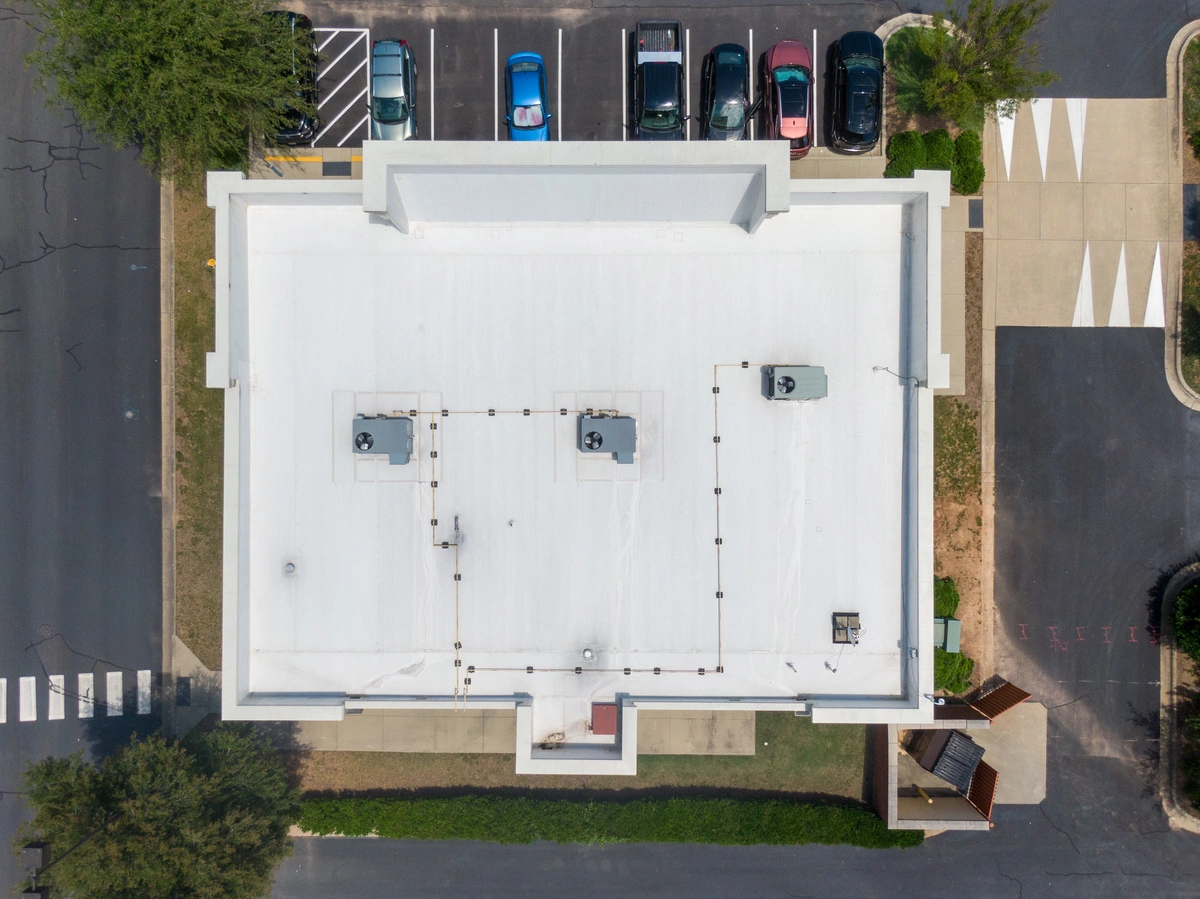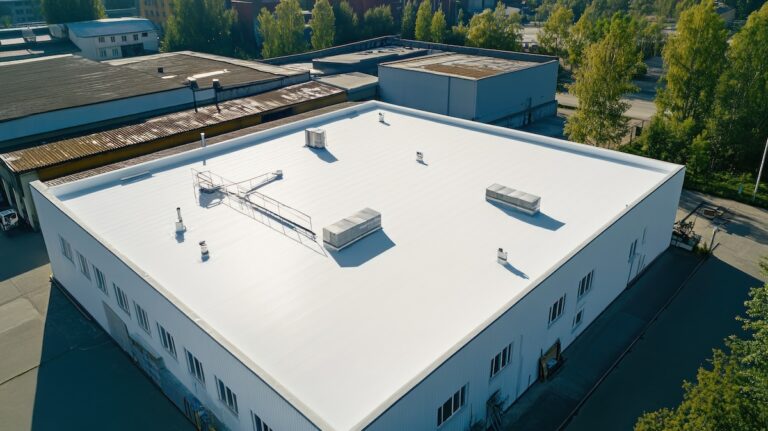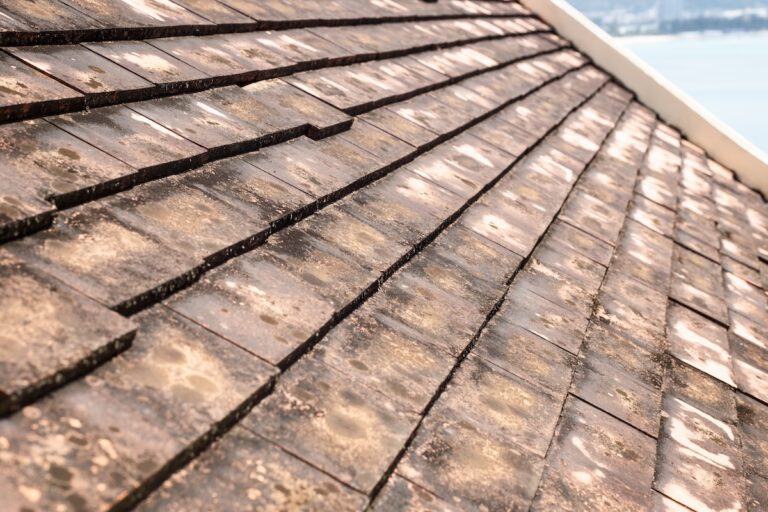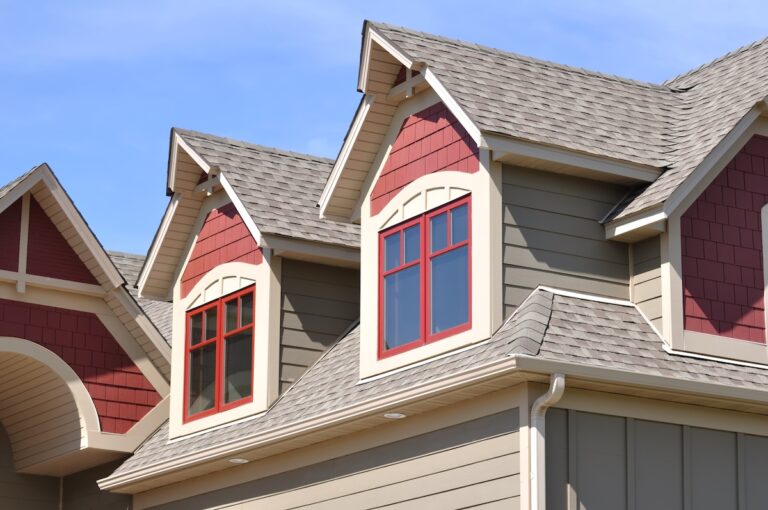Modern roofing solutions have come a long way from the traditional materials of yesteryears. Today, commercial property owners are more conscious of:
- Energy efficiency ⚡️
- Durability 💪
- Environmental impact 🌍
Thermoplastic Olefin (TPO) roofing is one of the most popular choices for commercial buildings due to its durability, cost-effectiveness, and energy efficiency. But what exactly is TPO roofing, and why is it so popular? In this guide, we’ll explore the benefits, applications, and considerations of TPO roofing to help you determine if it’s the right choice for your property.
One such contemporary roofing option that’s gaining immense popularity is TPO roofing. But what is a TPO roof, and why should you consider it for your home? This comprehensive guide aims to demystify TPO roofing, providing you with all the essential information you need.
Understanding TPO Roofing
Thermoplastic Polyolefin (TPO) roofing is a popular choice for flat or low-slope roofs, especially in commercial settings. This single-ply membrane combines durability, cost-effectiveness, and energy efficiency, making it a fast-growing roofing option.
Key Features of TPO Roofing
1. Composition
TPO is a synthetic material constructed with:
- TPO Polymer Base: Forms the foundation of the membrane.
- Polyester-Reinforced Scrim: Adds strength and flexibility.
- TPO Compounded Top Ply: Provides UV resistance and durability.
2. Benefits
- Highly Reflective: The white color reflects sunlight, reducing heat absorption and energy costs.
- UV Resistance: Resists degradation from prolonged sun exposure.
- Tear Resistance: Withstands impact and wear.
- Cost-Effective: Affordable compared to other single-ply membranes.
- Ease of Installation: Lightweight and adaptable for different roof designs.
3. Applications
- Ideal for commercial buildings with flat or low-slope roofs.
- Commonly used in warehouses, retail spaces, and industrial facilities.
4. Installation
- Installed as large sheets that are heat-welded together using specialized hot-air welding machines, creating strong, watertight seams.
Why Choose TPO Roofing?
TPO offers a balance of affordability, performance, and energy savings. Its reflective properties make it an environmentally friendly option, while its durability ensures long-lasting protection for your building.
Whether you’re considering a roof replacement or a new installation, TPO roofing is a reliable solution for commercial properties.

The History of TPO Roofing
TPO roofing is relatively new compared to traditional roofing materials like asphalt shingles and clay tiles. It was introduced in the 1990s as an affordable and more energy-efficient alternative to PVC (polyvinyl chloride) roofing. Over the years, TPO has been refined and improved, making it one of the most sought-after roofing options for both residential and commercial structures.
What Are The Benefits of TPO Roofing?
Not sure whether TPO roofing is right for you? Here are just some of the benefits you can look forward to, if you choose it:
- Energy Efficiency: One of the standout features of TPO roofing is its energy efficiency. The reflective surface of TPO membranes helps to reduce the amount of heat absorbed by your home, thereby lowering cooling costs. According to the U.S. Department of Energy, cool roofs like TPO can save homeowners up to 15% on their cooling costs during the hot summer months.
- Durability: TPO roofs are known for their robustness and long lifespan. They are resistant to tears, punctures, and impact damage. Many TPO membranes come with warranties of 20 years or more, making them a long-lasting roofing solution.
- Cost-Effectiveness: While TPO may initially be more expensive than traditional roofing materials, its long-term benefits often outweigh the initial costs. The energy savings and low maintenance requirements make TPO a cost-effective option in the long run.
- Environmentally Friendly: TPO membranes are recyclable at the end of their life cycle, contributing to environmental sustainability. Additionally, their energy-efficient properties help reduce the overall carbon footprint of your home.
- Resistance to UV Rays and Chemicals: TPO roofing is highly resistant to UV rays, ozone, and various chemicals, making it suitable for different climates and industrial settings. This resistance ensures that the membrane remains effective and intact for many years.
- Ease of Installation: Lightweight and flexible, TPO is easy to install, minimizing labor costs and downtime
How is TPO Roofing Installed? 5 Key Steps
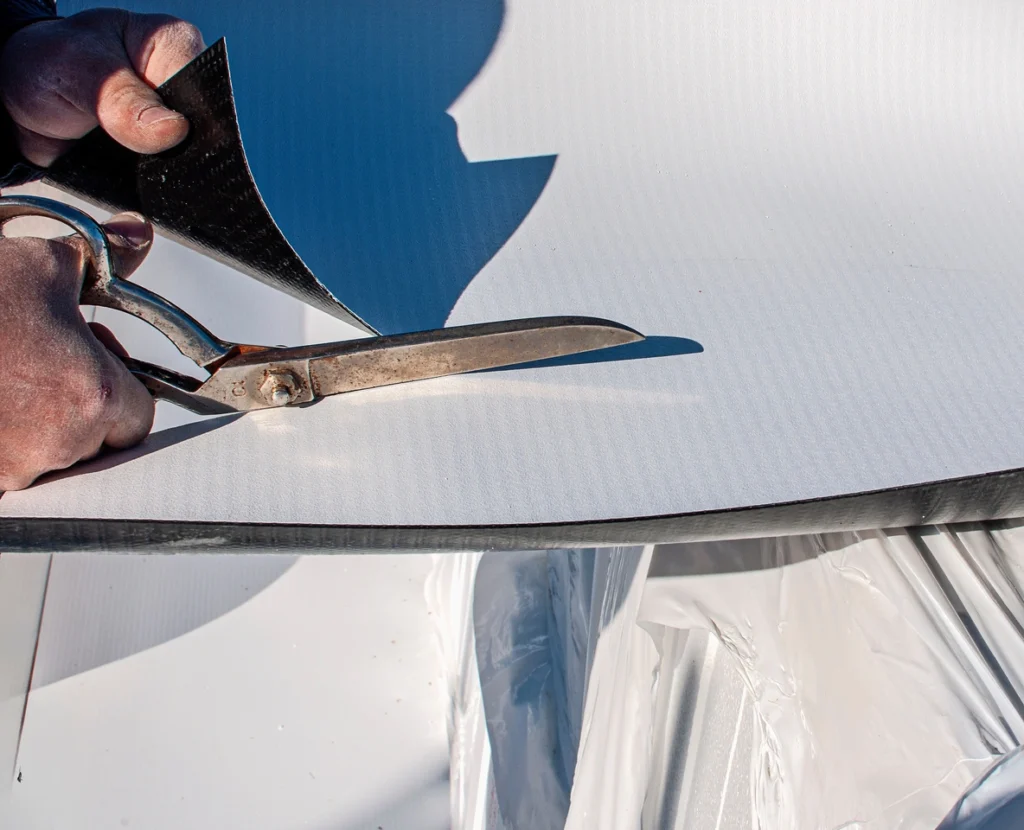
TPO roofing installation involves several key steps to ensure a secure and long-lasting roof. Here’s a simplified breakdown of the process:
1. Roof Deck Preparation
Before installing the TPO membrane, the roof deck needs to be properly prepared. This may involve cleaning, repairing any damaged areas, and ensuring the surface is smooth and dry.
2. Insulation Installation
A layer of insulation is typically installed over the roof deck to enhance the energy efficiency of the roofing system. Common insulation materials include polyisocyanurate, EPS (expanded polystyrene), and XPS (extruded polystyrene).
3. Membrane Attachment
The TPO membrane can be attached to the roof deck in several ways:
- Mechanically Attached: Fasteners and plates are used to secure the membrane to the roof deck.
- Fully Adhered: Adhesives are applied to bond the membrane to the insulation or roof deck.
- Ballasted: The membrane is loose-laid and held in place by adding ballast, such as river rock or pavers.
4. Seaming
Heat welding is used to join the seams of the TPO membrane. This creates a watertight seal that prevents leaks and ensures the integrity of the roofing system.
5. Flashing and Detailing
Special attention is given to flashing around roof penetrations, edges, and other details to ensure a fully waterproof system. This step involves using pre-molded accessories and additional membrane pieces to cover these areas.
Common Applications of TPO Roofing
TPO roofing is widely used in:
- Commercial buildings like warehouses and retail centers.
- Industrial facilities needing chemical-resistant roofing.
- Large residential complexes where energy savings are a priority.
Maintenance and Care for TPO Roofing
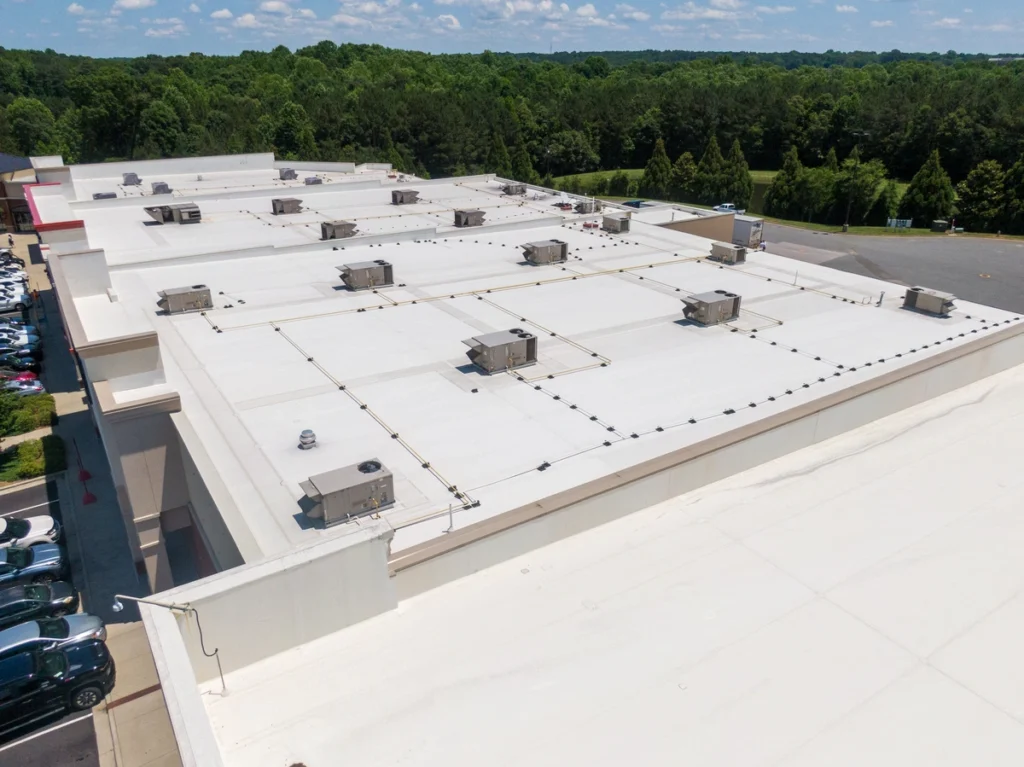
While TPO roofing is low maintenance compared to other roofing materials, regular inspections and care can prolong its lifespan. Here are some maintenance tips for TPO roofing:
Regular Inspections
Schedule regular inspections, at least twice a year, to check for any signs of wear and tear. Pay special attention to seams, edges, and areas around roof penetrations.
Cleaning
To maintain the longevity and efficiency of your TPO roof, keep its surface clean. Regularly remove debris, dirt, and algae, as they can trap moisture and lead to degradation over time. Use a mild detergent and a soft brush to scrub the membrane gently. For larger areas, a low-pressure washer is effective without risking damage to the roof’s surface. Cleaning not only maintains the roof’s reflective properties but also ensures optimal energy efficiency.
Prompt Repairs
Prompt attention to damage is critical for extending your roof’s lifespan. Small punctures, tears, or areas of wear should be repaired immediately to prevent water infiltration and structural deterioration. Use TPO-specific patches combined with heat welding for durable, seamless repairs. Regular monitoring ensures that minor issues don’t escalate into costly repairs or replacements.
Professional Maintenance
TPO Roofing vs. Other Roofing Materials
To help you make an informed decision, it’s essential to compare TPO roofing with other popular roofing materials. Here’s a quick overview:
TPO vs. PVC
While both TPO and PVC are single-ply membranes, there are some differences:
- Cost: TPO is generally more affordable than PVC.
- Flexibility: TPO is more flexible, making it easier to install and resistant to punctures.
- Environmental Impact: TPO is considered more environmentally friendly due to its recyclability.
TPO vs. EPDM
EPDM (Ethylene Propylene Diene Monomer) is another popular single-ply roofing membrane. Here’s how they compare:
- Reflectivity: TPO is more reflective, leading to better energy efficiency.
- Durability: Both materials are durable, but TPO has better resistance to UV rays and chemicals.
- Cost: EPDM is usually less expensive than TPO.
TPO vs. Asphalt Shingles
Asphalt shingles are a common roofing material for residential homes. Here’s a comparison with TPO:
- Lifespan: TPO has a longer lifespan compared to asphalt shingles.
- Energy Efficiency: TPO’s reflective properties make it more energy-efficient.
- Maintenance: TPO requires less maintenance than asphalt shingles.
- Cost: Asphalt shingles are generally more affordable initially, but TPO offers better long-term value.
Is TPO Roofing Right for Your Home?
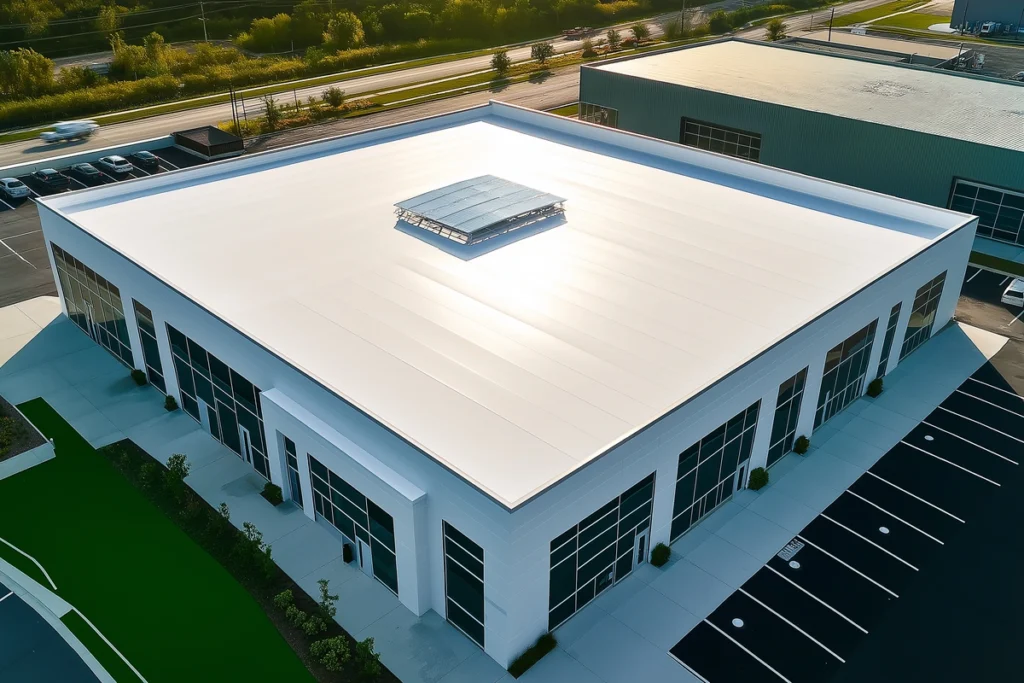
Now that you have a comprehensive understanding of TPO roofing, you may be wondering if it’s the right choice for your home. Here are some factors to consider:
🌤️ Climate
TPO roofing is suitable for various climates, but its reflective properties make it particularly beneficial in hot and sunny regions. If you live in an area with extreme temperatures, TPO’s energy efficiency can help keep your home comfortable year-round.
📐 Roof Slope
TPO roofing is primarily designed for flat or low-slope roofs. If your home has a steep-slope roof, you may need to explore other roofing options.
💵 Budget
While TPO may have a higher upfront cost compared to traditional roofing materials, its long-term benefits, including energy savings and durability, make it a cost-effective investment.
🌻 Environmental Impact
If you’re environmentally conscious, TPO’s recyclability and energy-efficient properties align with sustainable living practices.
Choosing a TPO Roofing Contractor
Selecting the right roofing contractor is crucial for a successful TPO roofing installation. Here are some tips for finding a reputable contractor:
- Research and Referrals: Start by researching local roofing contractors with experience in TPO installations. Ask for referrals from friends, family, or neighbors who have had TPO roofs installed.
- Check Credentials: Ensure the contractor is licensed, insured, and certified to install TPO roofing systems. Look for certifications from manufacturers, such as GAF or Firestone, which indicate the contractor’s expertise.
- Request Quotes: Get quotes from multiple contractors to compare pricing and services. Be wary of unusually low bids, as they may indicate subpar materials or workmanship.
- Read Reviews: Read online reviews and testimonials from previous customers to gauge the contractor’s reputation and quality of work.
- Ask Questions: Don’t hesitate to ask questions about the installation process, materials used, warranties, and maintenance recommendations. A knowledgeable contractor should be able to provide detailed answers.
Let Us Install Your TPO Roofing System
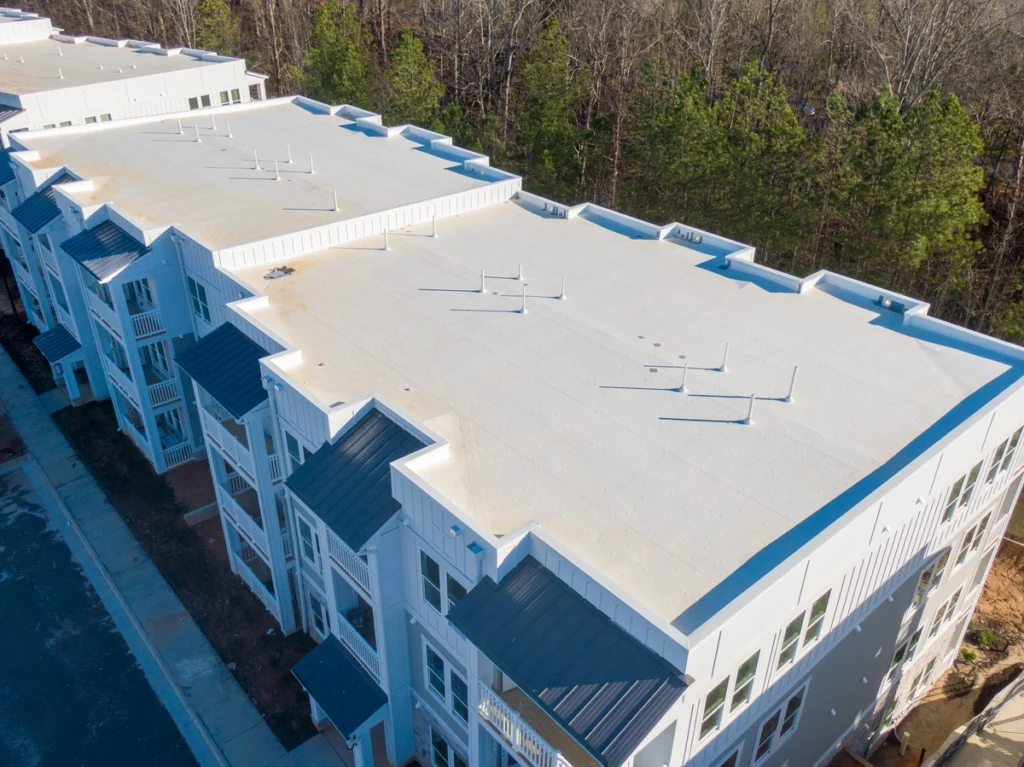
TPO roofing offers a modern, energy-efficient, and durable solution for homeowners seeking to upgrade their roofing systems. With its reflective properties, resistance to UV rays and chemicals, and long lifespan, TPO is a worthwhile investment that can enhance your home’s comfort and value.
If you’re considering TPO roofing for your home, take the time to research and choose a reputable contractor who can provide a high-quality installation. By doing so, you’ll enjoy the many benefits that TPO roofing has to offer for years to come.
Ready to explore TPO roofing for your home? Contact G. Cannon today to get started on your roofing project. Your home deserves the best, and TPO roofing may be the perfect solution for your roofing needs.
